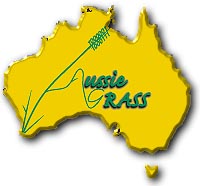Main Features
AussieGRASS environmental calculator
A multi-state collaboration with extensive calibration and validation

AussieGRASS is essentially a spatial implementation of Queensland Government GRASP (Grass Production) model. Within the AussieGRASS framework, GRASP is run on a daily time-step. The observed data are spatially interpolated to construct gridded datasets on a regular 0.05˚ × 0.05˚ grid (approximately 5 km × 5 km) across Australia. The spatial framework includes inputs of key climate variables (rainfall, evaporation, temperature, vapour pressure and solar radiation), soil and pasture types, tree and shrub cover, domestic livestock and other herbivore numbers.
Regional drought analysis
AussieGRASS was used initially as a regional drought analysis system. AussieGRASS goes beyond a simple analysis of rainfall and calculates important production variables such as pasture growth and pasture biomass. AussieGRASS not only integrates the impact of rainfall and its seasonal distribution, but also the impact of other climate variables such as evaporation and humidity.
AussieGRASS produces indices such as percentile pasture growth, total standing dry matter (TSDM), runoff and rainfall, at time scales of 1-36 months. This information has been an important component of the evidence-based assessment of drought, enabling more efficient and timely use of government funds.
Translating seasonal climate outlooks
AussieGRASS provides a platform for translating seasonal climate outlooks into estimates of future plant growth. It is a powerful tool for value-adding to climate information, as it takes into account current condition (e.g. soil moisture, ground cover, nitrogen status and grass basal cover) to provide a probabilistic view of plant growth for the coming three-month period. For example, a high probability of moderate rainfall in the next three months combined with low ground cover, poor perennial plant condition and a currently dry soil profile might lead to little or no plant growth.
Probabilities of pasture growth, runoff (flow to stream) and ground cover are estimated each month for the coming three-month period, with the potential for outlooks of pasture curing index and grass fire risk. AussieGRASS utilises output from the SOI Phase system, to produce the short-term pasture outlooks.
Managing our landscapes
AussieGRASS includes the impacts of total grazing pressure from domestic stock and other herbivores. Land degradation and recovery (documented in Learning from History; McKeon et al. 2004), as well as desertification, are ongoing issues that are likely to be exacerbated by climate change. AussieGRASS calculates pasture utilisation as an index of grazing pressure and takes account of animal consumption in making forecasts of ground cover. AussieGRASS outputs are not only provided on the Long Paddock website, but are also incorporated in various climate risk assessment reports and information systems.
Managing fire risks in the rural landscape
AussieGRASS calculates monthly estimates of pasture curing state and pasture grass fire risk (a combination of fuel load and curing state). In addition, the model is run every night to provide daily estimates of the biomass of fuel components (green grass, dead grass, grass litter and tree litter). These estimates are available for use by rural fire agencies in GIS based systems. Estimates of total standing dry matter for the coming three-month period are available on application.
Environmental analysis
AussieGRASS outputs are also being increasingly used for various environmental analyses, for example, estimating plant net primary production for soil carbon mapping, providing soil moisture as an initial condition for air pollution models, analysing how stock numbers influence the potential amount of biomass which can be burnt, analysing conditions suitable for dust storms and estimating the impact of removing tree cover on deep soil water infiltration.
Climate change and AussieGRASS
Daily climate projections data for 2030 and 2050 are being produced by Grazing Lands Systems' Consistent Climate Scenario’s project. When incorporated in the AussieGRASS modelling framework, this information will enable climate change impacts on pasture production and livestock carrying capacity to be readily assessed.
The effects of CO2 on plant transpiration efficiency and other functional parameters are included in GRASP, as is the impact of increases in the sub-daily rainfall intensity on soil erosion.
Additional products
The following products may also be available on application:
- Access to daily estimates of fuel load via FTP
- Experimental products and customised analyses


